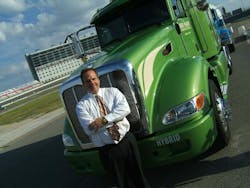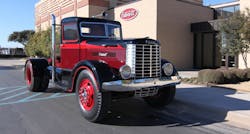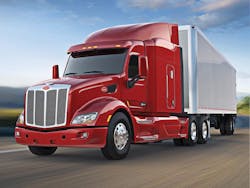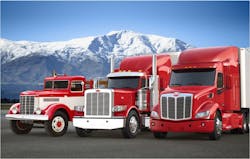That’s a tricky challenge, no doubt, and its one Landon Sproull (seen at right), chief engineer for Peterbilt Motors Co., understands all too well – one he’s faced during his 25 years with the company and one he expects to keep on facing in the future. [To view a photo gallery of some of Peterbilt’s latest models displayed at last year’s Mid America Trucking Show, click here.]
“When I started my career at Peterbilt, the diesel engines powering our trucks were all mechanically driven – not a single electronic system in sight,” he told me recently by phone. “For example, we still used accelerator rods to transmit throttle demand from driver to engine. Now that’s digitally controlled, along with almost everything else on today’s trucks.”
And that’s just what’s occurred during Sproull’s tenure at Peterbilt – a company celebrating its 75th anniversary this year.
[The video clip below shows Sproull introducing one of Peterbilt’s newer highway tractors, the Model 587, at the Mid America Trucking Show a few years ago.]
Then in 1958, PACCAR Inc. – then called Pacific Car & Foundry – purchased Peterman’s company, eventually relocating Peterbilt’s truck manufacturing operation to Newark, CA, in 1960. Peterbilt eventually opened second plant in Madison, TN, in 1969 to meet demand and better serve its customers from coast to coast. (A facility later closed down in 2009.)
In 1980, Peterbilt opened a new manufacturing facility in Denton, TX, where it remains today – eventually serving as its headquarters as well. Peterbilt also builds Class 6-7 trucks in Ste. Therese, Quebec, and is supplied with proprietary engines built by the PACCAR Engine division from a plant in Columbus, MS.
Today, Peterbilt trucks are distributed through a network of dealerships with more than 290 locations throughout the U.S. and Canada.
Sproull told me that start of the “modern era” in trucking began in 1990 as more aerodynamically-shaped truck exteriors and the first electronically-controlled engines made their debut.
“Look at that 1939 truck we recently bought – the sixth truck produced by Peterbilt,” he told me. “That’s a fairly simple vehicle but it’s lasted all this time – it’s still functional. That’s a testament to the durability and reliability of truck designs. The challenges are to deliver that same durability and reliability with trucks packed will all sorts of electronic systems, deliver excellent fuel economy, and yet stay in compliance with emission rules.”
Yet there’s another challenge in all of this as well – to keep the “classic” look and feel of highway tractors and vocational trucks demanded by customers.An example of how Peterbilt is trying to blend those two often distinctly separate “truck worlds” together can be found in the rollout of its Limited Edition Model 579; a model designation brought back to life from an era that revered the “squared off” long-nosed look of conventional highway tractors.
“It’s a truly unique tribute to both Peterbilt past and future,” noted Robert Woodall, Peterbilt’s director of sales and marketing in a statement. “It combines the Model 579’s advanced technologies, distinctive styling and state-of-the-art aerodynamics with numerous accents and details honoring the original 1939 Peterbilt.”
Peterbilt is also using a special edition Model 579 to haul a unique “museum on wheels” that will visit Peterbilt dealerships and industry events around the country; a converted trailer filled with displays, historic artifacts and interactive kiosks highlighting Peterbilt’s history – including an original 1939 Peterbilt crown and grille, timeline of significant company vehicles and achievements, interactive displays, and hands-on examples showcasing Peterbilt products and technologies.
Maintaining that historical “connection” to truck designs of the past is one of the many engineering challenges faced by Sproull and his team at Peterbilt on a daily basis.
[To view more trucks from Peterbilt's long history, click here.]
“Yet if you look at that 1939 Peterbilt and compared it to a modern-day Model 389, you can see that the design ‘theme’ is still there, especially in the three-bar design of the front grille” he pointed out. “Even with the more aerodynamic designs we need today for fuel economy, you can still see the shape of the ‘old’ Model 579 in the outlines of the ‘new’ one.”
All sorts of other changes continue to gain momentum as well, Sproull told me. “The shift from 15-lter engines down to 13-liter displacement will continue as the industry continues to seek better fuel economy,” he said. “We’re still going to see challenges driven by legislation as well, especially where CO2 (carbon dioxide)Yet truck engineers are being armed with more capability as well, equipped with computer aided design (CAD), finite element analysis (FEA), and other computer systems that enable them to more finally “tune” and entire truck right down to the nuts and bolts on the frame rails.
“We really take a ‘whole vehicle’ perspective when designed a truck, because even one weak point will eventually compromise the entire vehicle considering to tough environments where trucks operate,” Sproull explained to me. “Yet by using the new design tools we’ve been to build truck cabs that are lighter and don’t require much reinforcement that still out-performs the designs from 20 years ago.”
It will be interesting to see what hurdles Peterbilt’s engineers surmount next as the regulatory and performance demands placed on trucking will only grow in the future.




